
Lipid Synthesis & Degradation (The Living Cell)
Learning objectives Should be able to provided examples of the main lipids in the body Explain why fats are the major energy store in the body Describe under which circumstances fatty acids are synthesised and degraded Describe the major steps in both fatty acid synthesis and degradation Show an understanding of the regulation of cholesterol synthesis Describe the importance of ketone bodies in the delivery of energy to non-hepatic tissue
-
What are lipids?
Macromolecules soluble in non-polar solvents
-
List some examples of lipids (6)
-Fatty acids
-Glycolipids
-Glycerophospholipids
-Sphingolipids
-Triglycerides
-Cholesterol
-
When are Fats synthesised and stored?
When our calorific intake exceeds the immediate needs of the body
-
The energy content of fat per gram is over twice that of either....? Can you state the amount of kjoules per gram of these substances?
Carbohydrate or protein
1g fat - 37kjoules
1g protein - 17kjoules
1g carbohydrate - 16kjoules
-
Is there health complications to consuming a lot of calories?
Yes
Obesity
-
Fats are often made from dietary carbohydrates. What else can be used?
Amino acids
-
What is the preferred energy source of cardiac muscle?
Fat
-
Where is fat stored? And as what form? Where are the majority of Fats synthesised?
-Adipose tissue
-As triglycerides
-In the liver
-
Where does fatty acid synthesis take place in a CELL
The cytosol
-
What does fatty acid synthesis require?
•Acetyl-CoA
•NADPH
•ATP
-
Picture outlining the Transfer of acetyl CoA to the cytosol
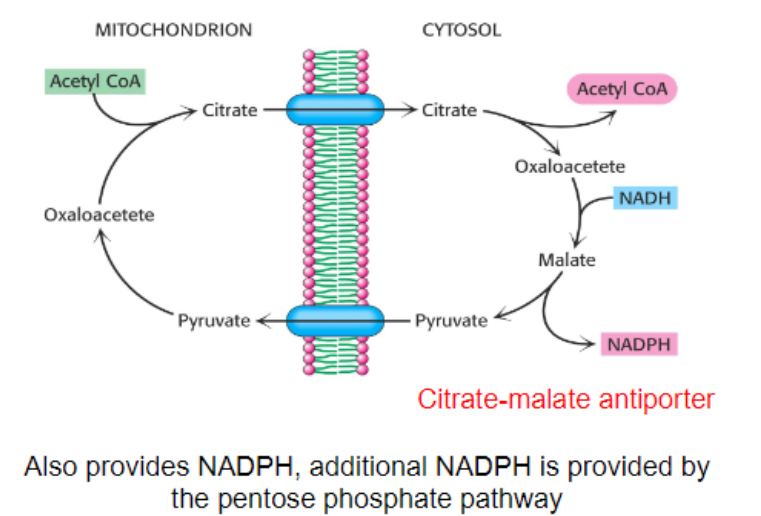
-
What is the first equation for fatty acid synthesis? What is it activated by? What is it inhibited by? What does this step require?

-Activated by citrate (positive feed forward)-Inhibited by palmitic acid (negative feedback)
-Requires the vitamin biotin
-
Outline the steps in Fatty acid synthesis
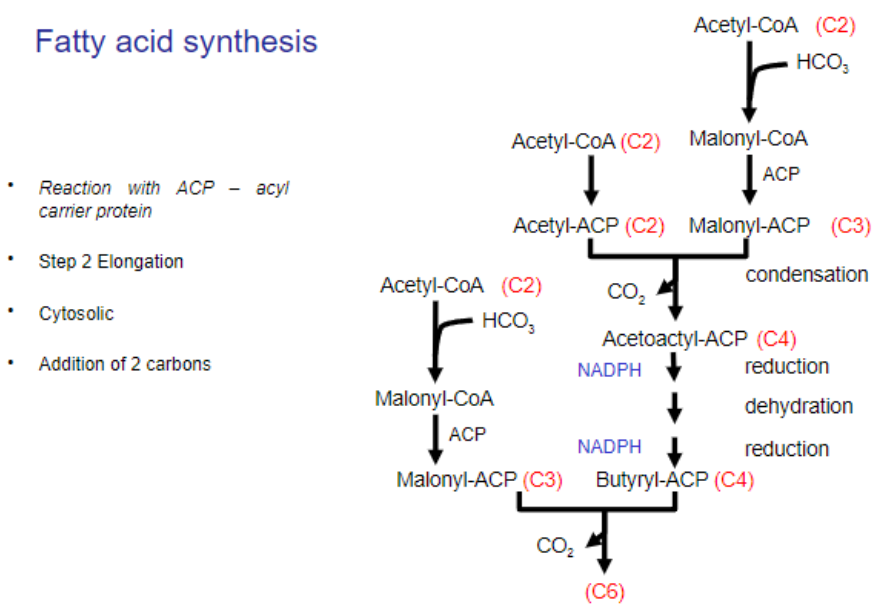
-
What does fatty acid synthase do?
Is an enzyme complex that plays a central role in de novo synthesis of long-chain fatty acids
-
Intermediates are covalently linked to acyl carrier protein (ACP), why is this useful? What other feature improves this reaction?
• This enables the efficient and rapid movement of the growing fatty acid chain to be passed from one active site to the next.
• The efficiency of the reaction is further enhanced as the enzyme exists as a dimer arranged head to tail
-
State some information about cholesterol: (5)
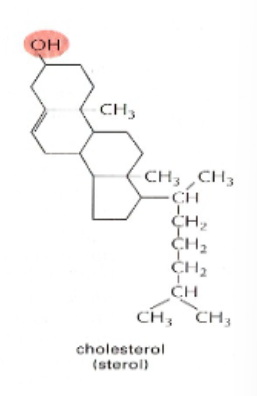
• Rigid hydrophobic molecule virtually insoluble in water
• Precursor of sterols, steroids and bile salts
• Important membrane components
• Transported in the circulation as cholesteryl esters
• Cannot be used to provide energy
-
Cholesterol is synthesised mostly where?
Cholesterol is synthesised mostly in the ER
-
How does cholesterol synthesis start?
Starts with the activation of acetate, acetyl-CoA
-
What is a major regulatory step in cholesterol synthesis?
The conversion of 3-hydroxyl-3-methylglutaryl CoA (HMGCoA) to mevalonate
-
Cholesterol inhibits what molecule?
Inhibits HMGCoA reductase, the enzyme involved in its own synthesis
-
Why is it difficult to reduce circulating cholesterol by diet alone?
Endogenous synthesis increases
-
Fatty acid degradation requires THREE steps; What are they? Where do they occur?
1)Mobilisation - adipocytes
2)Activation – liver cytosol
3)Degradation – liver mitochondria
-
Picture outlining the process of Fatty acid mobilisation
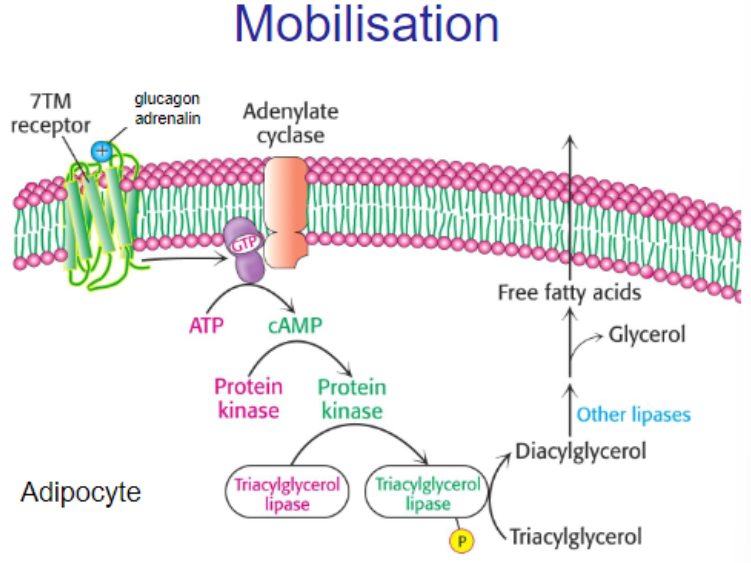
-
FILL IN THE BLANKS:
Fatty acid Degradation
•Fatty acids are transported to the liver and activated by_________ synthase in the cytoplasm to form ______________.
• Fatty acyl-CoA reacts with the ________ _______to form fatty acyl-carnitine
• Fatty acyl-carnitine is then transported across the______ _____________ _____________
Fatty acid Degradation
•Fatty acids are transported to the liver and activated by acyl-CoA synthase in the cytoplasm to form fatty acyl-CoA.
• Fatty acyl-CoA reacts with the alcohol carnitine to form fatty acyl-carnitine
• Fatty acyl-carnitine is then transported across the inner mitochondrial membrane
-
What does a carnitine deficiency cause? Why?
-Severe consequences, including muscle weakness or even death
-Without sufficient carnitine, the transport of activated fatty acids into the mitochondrial matrix is impaired, impacting energy metabolism
-
State the steps of fatty acid activation in the liver: (6)
Attachment of CoA:
Fatty acids attach CoA forming acyl-CoA.
Enzyme Catalysis:
Catalyzed by fatty acyl-CoA synthetase.
ATP Requirement:
Requires ATP for activation.
Location:
Occurs on outer mitochondrial membrane.
Formation of Acyl-CoA:
Results in the formation of acyl-CoA.
Preparation for Transport:
Acyl-CoA is prepared for mitochondrial transport and subsequent oxidation.
-
State the steps in Fatty acid oxidation (b-oxidation) (Liver mitochondria): (8)
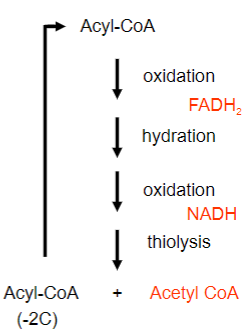
• Acyl-CoA degraded by sequential removal of two carbon units
• As a result, FADH2, NADH and acetyl-CoA are produced
• FADH2, NADH form ATP
• In the liver, Acetyl-CoA does not enter citric acid cycle
• In non-hepatic tissue, complete oxidation of palmitate yields 106 molecules of ATP
• Odd chain length yield propionyl-CoA in the last round of oxidation
• Propionyl-CoA is converted to oxaloacetate and used for gluconeogenesis
• Odd numbered double bonds are removed by isomerase and even double bonds by reductase and isomerase
-
Summary of Fatty acid synthesis: (5)
• Takes place in the Cytosol
• Intermediates linked to acyl-carrier protein
• Is the sequential addition 2C
• Process requires Reductant NADPH
• Fatty acid synthase enzyme complex
-
Summary of Fatty acid degradation: (5)
• Takes place in the Mitochondria
• Intermediates linked to coenzyme-A
• Is the sequential removal 2C
• Process requires Oxidants FAD and NAD
• Carried out be individual enzymes
-
What is ketogenesis?
-Is the metabolic process through which ketone bodies are synthesized in the liver from fatty acids
-This process occurs during periods of low carbohydrate availability or insufficient glucose utilization.
-
Outline the steps of Ketogenesis
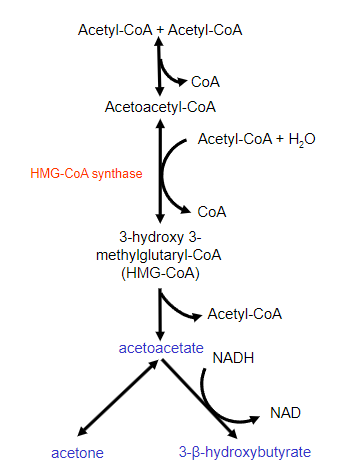
-
In the liver fasting, uncontrolled diabetes and prolonged exercisestimulates fatty acid breakdown producing...?
Acetyl-CoA
-
What happens during ketogenesis generally?
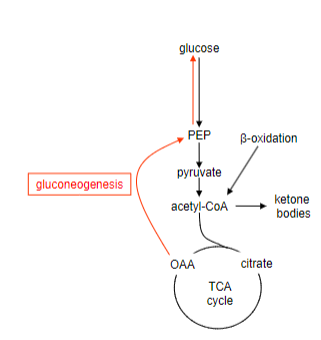
-Metabolism shifts towards maintaining blood glucose, leading to a reduction in OAA (Oxaloacetic Acid)
-Loss of OAA limits energy production from acetyl-CoA into the TCA cycle
-Excess acetyl-CoA is used to form ketone bodies In the liver
-
What are the ketone bodies?
-Acetoacetate
-3-β-hydroxybutyrate
-Acetone
-
What are the fates of the ketone bodies? (2)
-Preferentially used by cardiac muscle and renal cortex
-Used by the brain during starvation
-
Outline the steps of the ketone bodies fates
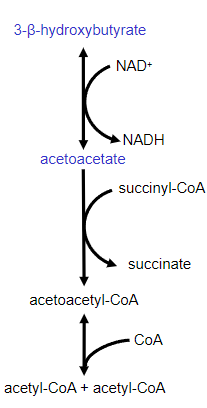
-
How is glycerol generated?
Breakdown of triglycerides gives acetyl-CoA and glycerol
-
What is glycerol used for in the liver?
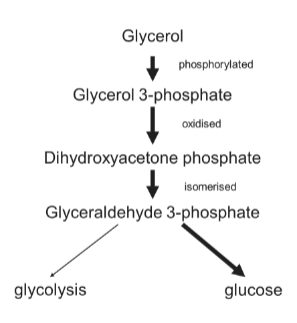
Used to synthesis glucose by gluconeogenesis
-
What is glycerol used for in the muscle?
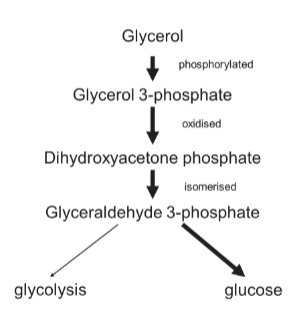
Used in glycolysis and oxidative phosphorylation to produce ATP
-
What are the roles of Insulin?
↑ glycolysis in the liver↑ Fatty acid synthesis in the liver↑ TG in adipose tissue↓ b-oxidation
-
What are the roles of Glucagon and adrenaline?
↑ TG mobilisation

